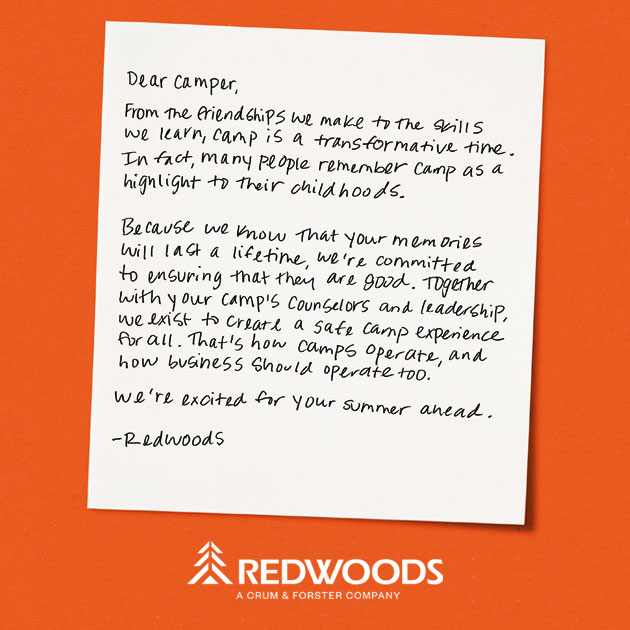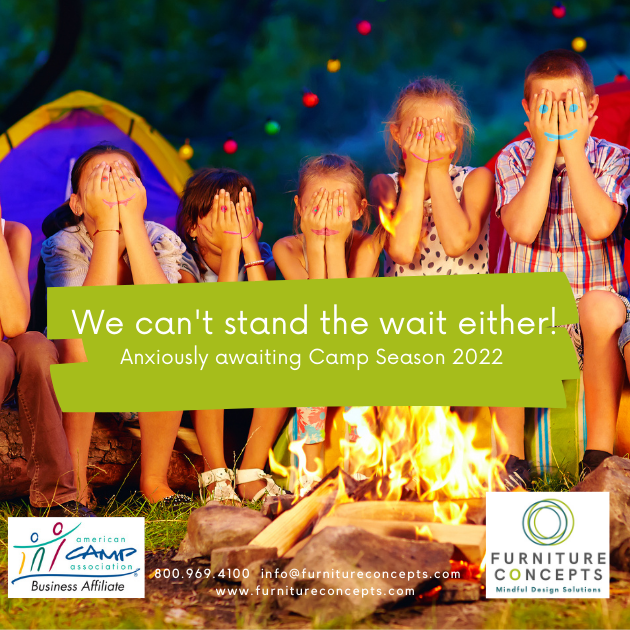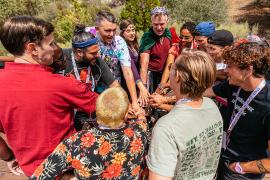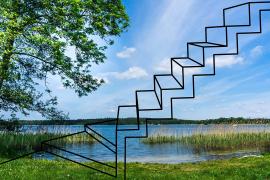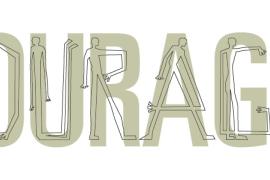We all know camp as a wonderful institution and a beloved piece of Americana. Just thinking of camp conjures images of sun-washed days spent canoeing and swimming, smoky nights around the campfire with s’mores and hot dogs, giggle-filled talent shows, and best of all, lifelong bonds. Many young people go to camp and find themselves in a supportive community for the first time and look forward to returning year after year as campers and eventually as staff. And while camp can be a special place where young people escape from the pressures of school, work, and extracurriculars, it is often also a place where struggles around identity continue. Many camps with the best of intentions unknowingly recreate some of the same systems that make it hard for young people to feel they truly fit in. Social justice and equity aren’t woven into the fabric of all camps — but they could be.
About the NCCJThe National Conference for Community and Justice (NCCJ) “is a human relations organization that promotes inclusion and acceptance by providing education and advocacy while building communities that are respectful and just for all.” People come to NCCJ to find out how they can create a space that welcomes everyone and makes them feel like they belong no matter what their identity. Through programs, coaching, and consulting, NCCJ supports people in all sectors — the workplace, the classroom, the community, and more — in learning about how their identity shapes their experience in the world. For more information on NCCJ programs and services, visit NCCJ.org. |
People can be empowered to recognize and address issues of identity openly and with courage and compassion. Of course, this isn’t something that can be accomplished overnight. Inclusion takes time, patience, and persistence — and must be about culture and practice working together to create a supportive and inclusive environment. For example, at the National Conference for Community and Justice (NCCJ) leadership and social justice camp, NCCJ ANYTOWN, social justice is an integral and inseparable part of the camp culture supported with intentionality and action.
NCCJ ANYTOWN was founded in 1950 in California, and by the 1980s had spread to NCCJ locations from coast to coast. NCCJ ANYTOWN was designed to ensure that inclusion and equity were not side projects paid attention to every so often. Instead, these principles are central to the camp’s ideology and functioning, which works to actively create an environment of inclusion, acceptance, and value of all identities. This is accomplished through a focus on policies — the rules that guide the camp and culture — that rely on atmosphere, accountability, openness, vulnerability, and strength to build a culture where there is a place for everyone.
An Inclusive Culture
Intentionality is part of the foundation of creating an inclusive culture. Often when people have discussions about how to give everyone a place at the table — or around the campfire — they begin by looking at how to increase diversity. Diversity is a good thing to have. When a population is diverse it brings in a richness of perspective and experience that is missing from homogenous spaces and allows us to see the world differently than we always have. The thing is, diversity is easy. When a space is diverse, it means that there are a variety of identities present. Convincing all kinds of people to attend our camps is a great first step, but it cannot be the only step. What we want to do is work toward inclusion, and inclusion requires active planning and a path to making camp feel like a home away from home.
An inclusive environment is one where the needs and abilities of all members of a community are considered, including these nine areas of social justice and identity:
- Race
- Class
- Gender
- Sex
- Sexual orientation
- Age
- Ability
- Religion
- Body size
An ideal camp environment is one where we are proactive in making space for all of these identities. Some of the questions we might ask about the natural environment include:
- Is the space difficult to navigate, or can wheelchair users or people with limited mobility access it? If not, are there alternatives available?
- Are there spaces for sitting or lying down in high-use areas?
- Are there opportunities to minimize noise and other stimuli or tranquil places where one can go when feeling overwhelmed?
Once questions about the natural environment are asked, we can move on to the built environment and the policies in place regarding how camp is set up, for example:
- Is there a variety of seating options for people of all body sizes?
- Are there bathrooms and cabin spaces for people of all genders?
- Is the cafeteria accommodating religious and allergy needs?
If you’re not certain what questions you should be asking to ensure your space is welcoming to all identity groups, this is the time to start reading and asking your own questions about the challenges these groups face.
Part of the process of an environmental review also involves closely examining the pieces of camp that are used to build community. Camp songs, games, and activities are often some of the most-loved pieces of camp culture, and something that campers can take home with them and easily share with their families and friends. But they can also be one of the biggest sources of unintentionally spreading around anti-inclusive ick. Camp directors should reflect on their favorite pieces of camp culture and think of ways that they might be problematic. If you’re not sure, ask for input from other professionals at your camp. The more diversity in the room, the more likely you are to see the issues.
A Learning Culture
Addressing the practical matters of how camp is run is only the first step. It is also important to create a culture where people have space to learn and grow. An optimal learning space is one where the guidelines and expectations are clear, but people also have room to make mistakes and learn from those mistakes. In areas of social justice and identity, we have all at some point said or done the wrong thing, leaving someone with less social power than we have feeling targeted and unsafe. The most important thing to remember is that this is going to happen! As human beings we were born to make mistakes, and when we’re not used to openly talking about a subject or we’re at the beginning of our learning journey, the likelihood of a blunder is even higher. We learn from these errors when they are normalized and confronted head on. Instead of striving to be perfect, which none of us can achieve, we create a space where everyone knows that it’s OK to make mistakes.
One of the most effective ways to do this is to have camp staff — adults and youth alike — become comfortable with modeling their own missteps. This can be a hard thing to do, especially if you are used to a culture where the goal is perfection. At NCCJ ANYTOWN the goal is never perfection but progress.
As an adult staff member, this author has made many mistakes around identity, and some of them have been pretty embarrassing for me. I’ve used the wrong gender pronouns, assumed someone was a race different from what they were — I could fill this entire page with my identity faux pas. When they’ve happened, it’s been tempting to pretend they never occurred or disregard them. But strong inclusion demands that they be addressed head on, and if I’m embarrassed about my gaffe, how much worse must the target feel? So, when these mistakes happen, staff must model accountability: apologize, speak to the victim privately, and let the rest of the camp know that amends were made. After all, missteps around identity don’t mean you’re a terrible person. They mean that you’re a person — period. Modeling fallibility and vulnerability empowers the campers to do the same and is a huge step toward inclusion.
This level of vulnerability will be even more effective when everyone in the camp, regardless of rank, can gently, openly, and honestly let other people know when they have unintentionally said or done something harmful around identity. Campers should be able to point out errors that staff have made, and staff must be able to reciprocate. When done correctly, this process may sometimes be difficult, but overall is experienced as an act of caring and building community as opposed to a gotcha moment. If inclusion is a core tenet of a community, then we must all work to keep each other accountable to creating that space.
This level of accountability can only happen when social justice and equity trainings are an ongoing and expected part of staff professional development. When we hold socially dominant identities, which most of us do, we are often unaware of the many ways in which we communicate our sense of dominance to identity groups who have less social power than we do. This can be something as simple as using the wrong pronouns, using a retired term to talk about race, or engaging in the casual fat talk that is a common way to bond in our country. We all learn that some people are more valuable than others. Unlearning this concept is a lifelong endeavor, and camps that want to create inclusion must embrace this willingly and joyfully. Be proactive in searching for training opportunities for staff and ensuring that everyone has equal access to those opportunities. There is no moment at which your equity work will be complete or that you have finally gotten it right. Even when you have a system in place that is working, remain open, flexible, curious, and ready for change — which is the only constant in the world of social justice.
A Commitment to Equity
The final piece of this journey toward inclusion is to be prepared to stand up and stand strong once a commitment to equity has been made. Growth is a beautiful thing, but it is often uncomfortable. Changing the way we do things can be met with resistance from campers, parents, staff, and even within ourselves. Be prepared to have your movements toward equity challenged. And when those challenges arise, stand firm in your belief that doing the right thing around equity will lead to a better camp experience for everyone. We don’t do equity work to rescue people with less social power than we have; we do equity work to create a camp — and a world — where everyone feels equally valued.
At NCCJ ANYTOWN we have a policy and practice of croissants, not donuts. This is the idea that we don’t want to create spaces that are closed to newcomers and to people who might be feeling unsure of their welcome or their place. Instead, we want to leave an opening for someone to walk right in and find friendship, camaraderie, and people who accept them for who they are and celebrate their right to exist in the way that feels most comfortable and authentic for them. Developing this space is the work of everyone in the community, and when we all participate, we simultaneously both give and receive space for authentic connection and existence.
Photos on pages 50–54 courtesy of Green River Preserve, Cedar Mountain, NC; Rochester Rotary Sunshing Campus, Rush, NY; Camp Robindel, Moultonborough, NH; Tom Sawyer Camps, Altadena, CA.
Reference
National Conference for Community and Justice. (n.d.). Mission. NCCJ. nccj.org/mission
Nyaunu Stevens is director of programs for the NCCJ.

